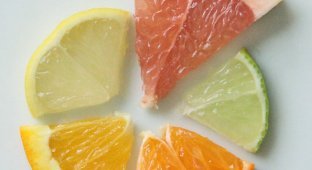Types of citrus fruits you didn't know about (13 photos)
Meet the citrus fruits most people haven't even heard of. Very serious work has been done) 60 types of citrus fruits that you didn’t know about.

1. Dancy tangerine is just a type of tangerine native to Morocco, Sicily, China and the United States. As a rule, tangerines are red-orange bright tangerines, sweet, with an easily peeled thin skin.
2. Orlando. The result of pollination of the Duncan grapefruit with pollen from the same Dancy tangerine.
3. Tangelo Nova is a hybrid of clementine and tangelo Orlando.
4. Thornton - a hybrid of tangerine and grapefruit.
5. Uglifruit - this drop-dead beauty happened by accident. In 1917, one J. J. R. Sharp, owner of Trout Hall Ltd. (now, as far as I understand, Cabel Hall Citrus Ltd.), Jamaica, found this gnarly crap in a pasture. Recognizing it as a likely hybrid of tangerine and grapefruit, he took a cutting from it, grafted it onto a sour orange and continued to regraft the offspring, choosing fruits with the fewest seeds. In 1934, for the first time, he gave the country so much uglifruit that he was even able to begin exporting it to England and Canada.
6. Tangelo Wekiwa, Canadian, light-skinned, the result of a repeated cross between a tangelo and a grapefruit.

7. Tangor is the result of crossing tangerine and sweet orange. Or rather, that is what is commonly believed. In fact, everything is a little more complicated. The most famous tangor is Temple (Temple, Temple, Temple). Its origin is not entirely clear.
8. Clementine. And this is a hybrid of a mandarin and a king orange, created by the French missionary and breeder Father Clement Rodier in Algeria in 1902. Actually, if you buy a tangerine, and it is somehow too sweet for a tangerine, it is quite possible that it is actually a clementine.
9. Natural tangor of the East - tankan. This culture has been cultivated since time immemorial in southern China, on the island of Formosa (Taiwan) and in the Japanese prefecture of Kagoshima. The tree on which the tankan grows is indistinguishable from a tangerine, but the fruits make one suspect that this citrus is a hybrid with an orange.
10. Ortanique – also probably a natural tangor. It was also found in Jamaica, but already in 1920. Since tangerine and orange trees grew nearby, they decided that it was a hybrid of them. The name was collected from the world along a thread - or (ange) + tan (gerine) + (un) ique.
11. Royal mandarin (Citrus nobilis, kunenbo, Kampuchean mandarin). His appearance is quite memorable, it rarely happens in our stores and is sold simply like a tangerine
12. Markot is also a famous tangor. And also of unknown origin. Florida tangors are called marcottes, the parent varieties/species of which are not known for certain. The first tree was found in 1922 and built in good hands.

13. Satsumas (inshiu, Citrus unshiu) Moroccan. All satsumas according to one version are a hybrid of citron and lime; the second is a hybrid of orange and lime.
14. Yemeni citron is an independent species.
15. Citron “Fingers (hand) of Buddha” looks like Cthulhu;)
16. Corsican citron. Please note - all these varieties have almost no pulp - only zest.

17. Kaffir lime (kaffir lime, kaffir lime, Citrus hystrix, Kaffir lime, porcupine citrus)
18. Etrog (efrog, Greek citron, tsedrat-citron, Jewish citron)
19. Persian (Tahitian) lime
20. Limetta (limetta, Citrus limetta, Italian lime, sweet lime)
21. Mexican lime (West Indian lime, sour lime). It is the Mexican lime that is usually painted on bottles and cans of all sorts of lime drinks.
22. Indian lime (aka Palestine, Palestinian sweet lime, Colombian lime) has long been considered a hybrid of lime and lime, but attempts to cross these plants did not result in anything similar.

23. Australian finger lime. It is also called citrus caviar.
24. Same. There are many varieties of them, with pulp of different colors. The origin is also unclear. The fruits look like multi-colored cucumbers. Australian chefs use the pulp of finger limes as a side dish, add it to salads and soups, and decorate fish and meat dishes with it.
25. Limandarins (limonias) - the results of crossing tangerines with limes or lemons. Limandarins have been bred in China since time immemorial. It is believed that the first Limandarin was the result of crossing a Cantonese lemon and a Cantonese mandarin. The Chinese red lemons that appear on our shelves are typical lemons.
26. Rangpur - Indian hybrid of tangerine and lime

27. Otaheite (sweet rangpur, Otaheite rangpur, Tahitian orange). This is also limandarine, also believed to be native to India. Discovered in 1813 in Tahiti, from where Europeans took it around the world.
28. Rough lemon or citronella. Originating from Northern India, it is a hybrid of mandarin and citron.
29. Pomelo. It is also Citrus maxima, Citrus grandis, pummela and sheddock - in honor of Captain Shaddock, who brought pomelo seeds to the West Indies (Barbados) from the Malay Archipelago in the 17th century. Huge round or pear-shaped fruits with a fairly thick zest, a lot of juicy pulp, and rough, easily separated membranes. One of the original citrus fruits, from which all their diversity comes. The pomelo peel is yellow, green, and the pulp is yellow, green, and red.
30. Pomelo with lime.
31. Hybrid – Duncan grapefruit, variety bred in Florida, in 1830.
32. Also a hybrid - Hudson grapefruit

33. A very famous hybrid of pomelo - oroblanco. This is the result of crossing the Siamese sweet pomelo and the Marsh grapefruit.
34. Sweetie - grapefruit hybrid from Israel
35. New Zealand grapefruit. It is called grapefruit, but it is believed to be either a natural tangelo or a hybrid of pomelo and grapefruit. The place of origin is also unclear - either China or Australia. Considerably sweeter than most grapefruits.
36. Chironha is a citrus whose fruits are the size of grapefruits and taste more like oranges.

37. Calamondin (aka golden lime, Panamanian orange, calamansi, musk lime), the result of crossing a tangerine (sunkey) and a kumquat
38. Yuzu (ichandrin, young) - the result of crossing sunka and ichang-papeda (ichang lime)
39. Kumquat. These are small, yellow or orange fruits, about the size of the outer phalanx of an adult man’s thumb, similar in shape to miniature lemons. They are usually sold in large grocery stores, in laminated foam trays. They appeared in Russia relatively recently, just a few years ago. At first they were hellishly expensive, but today they have become cheaper. Now, if you haven’t tried them yet, you’ve probably seen them
40. Limequat Eustis (hybrid of Mexican lime and round kumquat)
41. Mandarinquat Indio
42. Lemonquats (lemon + kumquat) and orangequats (orange or trifoliate + kumquat). But, pay attention, faustrime is a hybrid of the Eustis limequat and the Australian finger lime.

43. Sevillano, Seville bitter orange. In Seville they produce 17 thousand tons per year. Bitter oranges are not eaten fresh, they are not used to make juice, but they are used in the hybridization of citrus fruits, used to make orange bitters, to add orange flavor to liqueurs, and also as a seasoning for fish and as a raw material for the production of aromatic oils.
44. Citrangequat is a hybrid of citrange (which in turn is a hybrid of orange and trifoliata, also known as poncirus) and kumquat.
45. Bitter orange kikudaidai (Japanese citrus, canaliculata) is a purely ornamental plant. In Japan it is grown to admire
46. Bergamot (bergamot lemon, Bergamasco sour orange) - a type of bitter orange with a very bright, recognizable smell - used in perfumery
47. Sweet orange Citrus sinensis - Chinese citrus.
48. Hybrid of sour orange and pomelo - natsudaidai or natsumikan

49. Citrus sinensis - from the inside.
50. Blood oranges. Their Russian name is kings. Americans call them blood oranges. The bloodiest sanguinelli...
51. ...and sanguinelli

52. Fruit of papeda ichang. Use papeds for hybridization
53. Poncirus is an independent genus of the subfamily of the orange family Rutaceae, which includes one single species - trifoliata or poncirus trifoliata.
54. Citremon – a hybrid of trifoliate and lemon
55. Kabusu (kabosu) - a Chinese, but especially popular in Japan, hybrid of papeda and orange

56. Eremocitrus or Australian dessert limes. This is also a separate subgenus of citrus fruits. Eremocitrus has a stunning shaggy tree and small green fruits
57. Murrayi is a separate genus of the rue family, not citrus. But their fruits are similar to citrus fruits, and therefore everyone who is involved in breeding, studying and hybridizing citrus fruits is also interested in Murrays. Murraya is also called orange jasmine.

58. Severinia is also close to citrus fruits
59. Afrocitruses or citropsis. They are African cherry oranges. These are trees with small edible fruits that vaguely resemble citrus fruits.
60. Lemon feronia, sour limonia or Indian wood apple. Indian wild rue with very sour (although they say there are also sweet) edible fruits with an almost wooden peel.
61. Ceylon Orangester. Orangester fruits are very bitter, but the leaves, when rubbed and broken, have a strong lemon aroma.






















